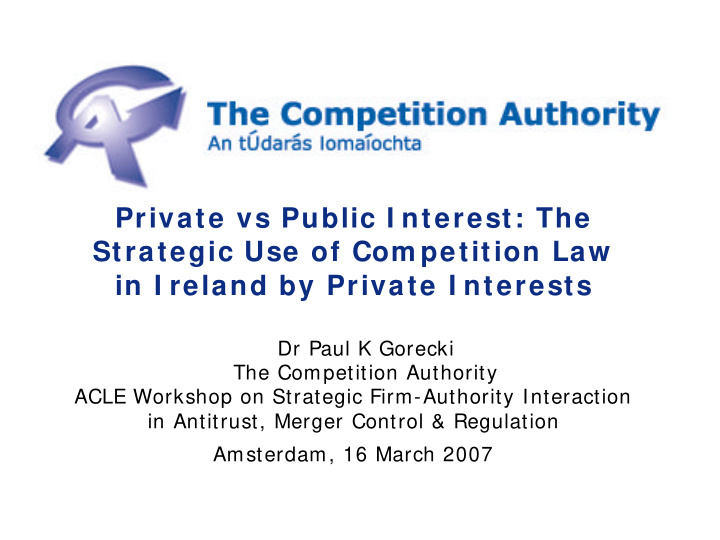



Private vs Public I nterest: The Strategic Use of Com petition Law in I reland by Private I nterests Dr Paul K Gorecki The Competition Authority ACLE Workshop on Strategic Firm-Authority Interaction in Antitrust, Merger Control & Regulation Amsterdam, 16 March 2007
Structure of Presentation 1 . Strategic Firm Behaviour and the Com petition Authority 2 . Com petition Authority Dilem m a: How to encourage the ‘right’ set of com plaints from firm s? 3 . Analyse Pro and Anti Com petitive Strategic Firm Behaviour 4 . Encourage Pro-Com petitive Strategic Firm Behaviour
W hat is Strategic Behaviour by Firm s? 1 . Definition: “Strategic behaviour is the general term for actions taken by firms which are intended to influence the market environment in which they compete. Strategic behaviour includes actions … to raise the firm's profits at the expense of rivals.” (OECD) 2 . Business problem s = breaches of Com petition Act ( ?) 3 . Question for firm : How can the Competition Authority assist the firm in resolving the its business problems?
Outside Looking I n: Perception of the Authority 1 . More than doubled in size (N= 55 persons in 2006) 2 . I nvestigations • Searches (N= 24 per year, 2003-06)) • Sum m ons (N= 53 per year) • Com plaints exam ined (N= 331 per year) 3 . Prosecutions • Civil (N= 8 total, 2003-06) • Criminal (N= 4 total)
I ncentives for Strategic Firm Behaviour 1 . Authority investigation can im pose costs on rivals • Senior management time • Disruption of ongoing operations • Damage rival’s reputation • Legal and economic expenses 2 . Expected outcom e: rival com petes less aggressively and/ or changes conduct
Com petition Authority Dilem m a 1 . Business an im portant source of inform ation about breaches of com petition law yet not all com plaints are breaches 2 . How to encourage the ‘right’ ( ie pro- com petitive) set of com plainants. • Analyse pro competitive vs anti-competitive complaints. Is there a difference? What are the implications? • Influence behaviour of firms so only submit pro- competitive complaints
I m portance of Business Business the Major Source of Full I nvestigations ( 2 0 0 3 -06, total) Number (% ) • Business 20 (64% ) • Own initiative 10 (32% ) • Other 1 (3% ) • Total 3 1 ( 1 0 0 % )
Anti-Com petitive Strategic Firm Behaviour 1 . Slow ing dow n change – vertical relationships • Margin reduction • New technology 2 . Preventing incum bents from com peting vigorously – horizontal relationships • Below cost selling/ predatory pricing
Pro-Com petitive Strategic Firm Behaviour 1 . Refusal to supply in order to: • Maintain a restrictive horizontal agreement (eg geographic market allocation, common terms and conditions for tenders) • Discourage the entry of a rival • Prevent new product launch 2 . Discrim inatory pricing/ lack of transparency • support schemes for new air routes
Pro vs Anti Com petitive Strategic Firm Behaviour:Spot the Difference 1 . Anti-com petitive strategic firm behaviour • Pricing issues 2 . Pro-com petitive strategic firm behaviour • Refusal to supply as a method of either enforcing a restrictive arrangement or as discouraging the entry of a rival or introduction of a new product
Encouraging Pro-Com petitive Strategic Firm Behaviour Encouraging the Right Stuff • Object of competition law is to make markets work well for consumers NOT competitors • Use effects based approach to evaluating allegations • Publish reasoned decisions in individual cases • Guidance notes on practices/ conduct
Recommend
More recommend